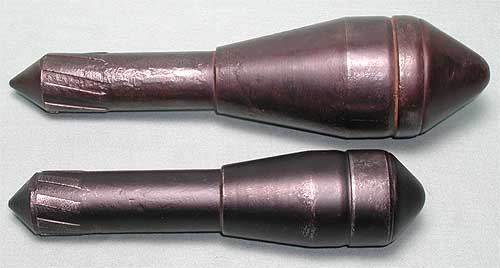
The German Wehrmacht seemed content with not developing
any larger HEAT grenades for their Schiessbecher, but the SS
had other ideas. Having difficulties obtaining the weapons they wanted,
the
SS went outside normal procurement channels to obtain what they
desired, something they continued to do throughout the war.
(The British discovered the advantages
of outside procurement as well, creating their famous department M.D.1,
also known as "Churchill's Toyshop"...but that is another story.)
The reverse taper
Grosse Gewehrpanzergranate
was
not a effective geometry and and there were simplifications that could
be made as well. The result was the Gewehrpanzergranate 46 and later
the still larger Gewehrpanzergranate 61. These were different
grenades entirely, from a simplified single piece drawn sheet metal body
and shaft construction to a new base fuze design.
The Gewehrpanzergranate 46's warhead diameter was 4.6cm with an overall
length of 93mm and carried a shaped charge of 150g. It had an armor penetration
of 90mm.
A further improvement was the Gewehrpanzergranate 61 which increased
penetration performance to 125mm. Its warhead diameter was enlarged to
61mm and carried a shaped charge of 200g.
Both types, Gew.Pz.Gr.46 and Gew.Pz.Gr.61, were produced in very small
numbers towards the end of the war.


